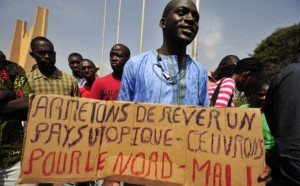On July 12, young protesters from Mali’s northern region of Gao clashed with police forces as they demonstrated against the nomination of former armed rebels as interim local government authorities. As part of the 2015 Algiers Peace Agreement to end a period of conflict in Mali, these former fighters will replace elected local officials in Gao and other northern regions of the country, pending new local elections.
According to Gao’s youth groups, those rebels are not representative of the population of Gao — and should not be named as potential local officials. Mali’s experience suggests that the country’s young people are making their voices heard in the decisions that shape the nation’s future.
The Gao protests quickly turned violent, with three protesters killed and at least 40 injured. Thousands more young people then demonstrated in the capital city, Bamako, and in the northern region of Timbuktu to demand the inclusion of youth in the implementation of the 2015 agreement that put an end to the 2012 Tuareg rebellion.
Mali continues to seek peace and stability
Since 2012, when rebels took up arms against the central government and declared an independent northern state, Mali has struggled with terrorist attacks and skirmishes in the north between rebel factions and pro-government militias. Rebuilding the population’s confidence in the government has been a challenge.
After the rebellion, a military coup deposed Mali’s democratically elected president, Amadou Toumani Touré. The coup marked an abrupt end to 20 years of democratic political stability. It also created a security vacuum, and Islamist groups took advantage of the chaos to sideline the rebel separatists in the north and establish their own form of theocratic governance, a form of rule that was very unpopular with most Malians.
In early 2013, a coalition of French and West African military forces began working to liberate northern Mali from these Islamist groups. In 2015, the national government reached an agreement with the different rebel factions to begin the process of reconciliation and long-term peace.
Youth in Mali have a long history of activism
Since its creation in the late 1970s, the National Union of Students and Pupils of Mali (UNEEM) has helped guide the country’s democratic youth movements. Malian students were among the main actors in the March 1991 revolution that toppled dictator Moussa Traoré. They also sustained the most casualties on March 22 of that year, a day Malians refer to as “Black Friday” in memory of the 300 young Malians who lost their lives.
Two decades later, following the 2012 military coup, Les Sofas de la République, a youth group that includes artists and musicians, media professionals, political parties and civil society groups, was created. It promoted a dialogue between those in favor of the coup and those advocating the strict application of the country’s constitution, which had been suspended by coup leaders.
In 2015, following the peace accord, youth groups, women’s organizations and other civil society groups demonstrated in Bamako in support of the government’s efforts to come to an agreement with rebel groups and the implementation of the Algiers Peace Agreement.
The political agenda of ‘We’ve had enough’
These youth movements have become increasingly organized and powerful. The newest group, “A Sera a Dana” or “Trop c’est trop” — which means “We’ve had enough” in the Bambara and French languages, respectively — echoes neighboring youth movements such Senegal’s “Y’en a marre” and Burkina Faso’s “Balai Citoyen.” Both of these youth movements began in recent years in response to presidents seeking to extend their terms in office.
Trop c’est trop is gaining traction, thanks to the involvement of celebrities and a dozen or so civil society youth movements. Following in the footsteps of the Y’en a marre movement, Trop c’est trop has a political agenda: preventing injustice in Mali and denouncing Malian President Ibrahim Boubacar Keita’s administration, which has been plagued by corruption and nepotism.
With 48 percent of its population just 15 or younger, Mali — and its future outlook — clearly will be shaped by how Malian youth perceive and understand the post-Algiers peace and rebuilding framework.
In the 2012-2013 period, during the absence of Malian government authorities in the north, youth from Gao integrated self-defense militias that were instrumental in resisting the jihadist invasion.
According to the mayor of Gao, Sadou Harouna Diallo, Gao’s youth also assumed police duties during that period. They put down their weapons after the 2013 presidential election, expecting to be reintegrated into the civil service or the army as part of the peace accord’s demilitarization, demobilization and reintegration (DDR) process. However, the DDR process was directed exclusively at former rebels and failed to take into account the now-jobless Malian youth who feel entitled to some recognition from their government for their service during a time of great unrest.
Mali’s challenging political and security contexts have made the power and legitimacy of youth movements a reality. Finding a route to peace and stability will require the country’s youth to buy into the process.
washingtonpost.com



